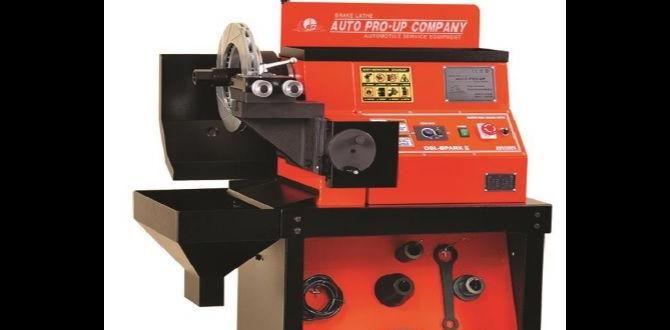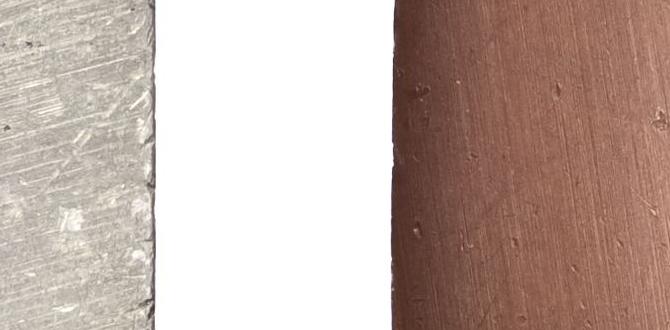A 1/8 inch carbide end mill is a fantastic choice for cutting tool steel, offering precision and durability. This versatile tool excels at creating intricate details and pockets, making tool steel machining much more manageable for beginners.
H
Ever looked at a piece of tough tool steel and wondered how you’d ever cut it cleanly? It can feel like a real challenge, especially when you’re starting out. The good news is, you don’t need a super-expensive setup to get amazing results. A small but mighty tool, the 1/8 inch carbide end mill, is your secret weapon. It’s perfect for those detailed jobs and proves that precision doesn’t have to be intimidating. Get ready to tackle tool steel with confidence, because we’re going to break down exactly how this little mill can help you achieve big success in your workshop.
Why a 1/8 Inch Carbide End Mill is Your Go-To for Tool Steel
When you’re working with materials like D2 tool steel, you need a cutting tool that’s up to the task. Tool steel is known for its hardness and ability to hold an edge, which is great for the final product but tough on your cutting bits. This is where a carbide end mill truly shines. Unlike High-Speed Steel (HSS), carbide is a composite material that is significantly harder and more wear-resistant. This means it can handle the high temperatures and forces involved in cutting tough metals without dulling or breaking as quickly. A 1/8 inch size is particularly useful because it allows for fine details, small pockets, and precise cuts that larger end mills just can’t achieve.
The Power of Carbide
Carbide, often tungsten carbide, is made by sintering fine particles of tungsten carbide powder with a binder material, usually cobalt. This process creates an incredibly hard and rigid material. For machining, this translates to:
- Superior Hardness: Carbide is much harder than HSS, allowing it to cut materials that would quickly wear down HSS tools.
- High Heat Resistance: Machining generates heat. Carbide can withstand much higher temperatures than HSS, meaning it stays sharp for longer even when cutting hard materials.
- Better Wear Resistance: Because it’s harder and more heat-resistant, a carbide end mill will maintain its cutting edge longer, providing more consistent results over its lifespan.
- Potential for Higher Speeds: Due to its ability to handle heat, you can often run carbide end mills at faster cutting speeds and feed rates than HSS, which can speed up your machining time.
Why 1/8 Inch? Precision and Versatility
The 1/8 inch diameter isn’t just a random size; it’s chosen for its specific advantages when working with tool steel or when intricate work is needed:
- Detail Work: For creating small engravings, fine slots, or detailed profiles, a 1/8 inch end mill is essential. It allows you to get into tight spaces where larger tools simply won’t fit.
- Pocketing Small Areas: If you need to mill out a small recess or pocket, this size offers excellent control and accuracy.
- Reduced Cutting Forces: A smaller diameter tool generally exerts less force on the workpiece and the machine. This is beneficial for lighter-duty milling machines or when working with thinner materials, reducing the risk of workpiece deflection or tool breakage.
- Versatile for Different Setups: Whether you’re using a CNC mill or a manual milling machine, a 1/8 inch end mill is a common size to have in your arsenal.
Choosing the Right 1/8 Inch Carbide End Mill for Tool Steel
Not all 1/8 inch carbide end mills are created equal, especially when you’re targeting tough materials like tool steel. Here are the key features to look for:
Material Considerations
When it’s specified as a “tool for tool steel,” it usually means the end mill itself is made from a high-quality carbide grade suitable for these hard materials. Look for end mills designed for hardened steels, often listed with their “hardness rating” capability.
Number of Flutes
The number of cutting edges, or flutes, significantly impacts how an end mill performs. For tool steel, especially for general-purpose milling, you’ll most commonly encounter end mills with:
- 2 Flutes: These offer good chip clearance, which is crucial when cutting tough materials that produce stringy chips. They are generally better for slotting and pocketing.
- 4 Flutes: These provide a smoother finish and can handle higher feed rates when milling on the side of the tool (contouring). However, they can pack up with chips more easily, so good chip evacuation is vital.
For dry cutting tool steel, 2-flute or 4-flute end mills designed for high-performance applications are often recommended. The ability to evacuate chips effectively is paramount to prevent heat buildup and tool damage.
Shank Diameter
Your prompt mentioned a “1/8 inch 10mm shank.” This is a bit of a clarification needed: usually, an end mill has a shank diameter that matches its cutting diameter, or it’s a larger diameter shank for increased rigidity. A tool specified as “1/8 inch (cutting diameter) with a 10mm shank” means the part that cuts is 1/8 inch, but the part that goes into the collet or tool holder is 10mm. This is common for longer end mills where a larger shank provides more stiffness to prevent bending or vibration, especially for “extra long” versions.
- 1/8 inch Shank: A 1/8 inch end mill with a 1/8 inch shank is standard. It provides good balance between cutting diameter and holder compatibility.
- 10mm Shank: If the end mill has a 1/8 inch cutting diameter but a 10mm shank, it indicates a longer tool designed for extended reach. The 10mm shank offers more rigidity than a 1/8 inch shank would for the same length, helping to maintain accuracy. Manufacturers often use larger shanks on longer tools for this reason.
Length and Reach (“Extra Long”)
The term “extra long” means the end mill has a longer flute length and overall length than a standard end mill. This is beneficial for milling deeper pockets or reaching into features that are far from the machine’s axis. However, extra-long tools are also more prone to vibration and deflection. This is where the sturdier shank (like a 10mm on a 1/8″ tool) becomes important, as does a rigid machine setup and careful machining parameters.
Coating
While not always present on basic 1/8 inch end mills, specialized coatings can further enhance performance for tool steel. Coatings like TiALN (Titanium Aluminum Nitride) or TiCN (Titanium Carbon Nitride) can increase surface hardness, reduce friction, and improve heat resistance, leading to longer tool life and better cutting performance. For dry cutting, a good coating is even more beneficial.
Dry Cutting vs. Wet Cutting Tool Steel
The phrase “dry cutting” in your keyword is significant. Traditionally, machining steel, especially tool steel, involves using a coolant or cutting fluid. Coolant lubricates the cutting edge, flushes away chips, and most importantly, dissipates heat. However, dry cutting is becoming more common, particularly with advanced tooling and machines for a few reasons:
Pros of “Dry Cutting” End Mills:
- Cleanliness: No cutting fluid means less mess, easier cleanup, and no disposal issues.
- Cost Savings: Eliminates the cost of buying, maintaining, and disposing of coolants.
- Material Compatibility: Some materials may be sensitive to certain coolants, or you might want to avoid contamination.
- Specific Tool Designs: End mills designed for dry cutting often have geometries and coatings optimized to handle the heat generated without fluid.
Cons and Considerations for Dry Cutting Tool Steel:
- Heat Management is Crucial: Dry cutting significantly increases the heat at the cutting zone. This is the biggest challenge. Tooling designed for dry cutting (like those with specific coatings or geometries) is essential.
- Tool Wear: Without adequate cooling, tool life can be dramatically reduced if the tool overheats.
- Chip Evacuation: Efficient chip removal is paramount to prevent chips from re-cutting and building up excessive heat.
- Material Limitations: Not all tool steels are ideal for dry cutting without specialized setups. Very deep cuts or very hard grades might still benefit from coolant.
For a 1/8 inch carbide end mill used for dry cutting tool steel, you’ll want to prioritize excellent chip evacuation (often meaning higher helix angles and fewer flutes like a 2-flute design) and a robust coating (like TiALN) to manage the heat. Ensure your machine is rigid and capable of maintaining consistent cutting parameters.
Safely Operating Your 1/8 Inch Carbide End Mill
Safety is always the top priority in any workshop. Machining, especially with hard materials, requires attention to detail. Here’s how to stay safe:
- Wear Safety Glasses: Always wear ANSI-approved safety glasses. Eye protection is non-negotiable when operating any machinery. A full face shield offers even better protection.
- Secure Your Workpiece: Ensure the workpiece is firmly clamped or fixtured to the milling machine table. Loose workpieces are dangerous and can lead to poor cuts or tool breakage.
- Proper Tool Holding: Use a high-quality collet or tool holder that is clean and free of debris. A well-balanced tool holder is important, especially at higher speeds, to prevent runout and vibration.
- Setup and Alignment: Make sure the end mill is correctly installed in the collet and that the spindle is properly aligned.
- Clearance and Guards: Keep hands and clothing away from the moving parts and cutting area. Ensure any machine guards are in place.
- Chip Management: Be aware that chips can be hot and sharp. Use a brush or shop vacuum (never your hands) to remove chips from the workpiece and machine, especially during dry machining.
- Know Your Machine’s Limits: Don’t try to push your machine beyond its capabilities. Start with conservative speeds and feeds, especially when working with tough materials.
- Emergency Stop: Familiarize yourself with the location and operation of your machine’s emergency stop button.
Setting Up Your Milling Machine for Success
Getting your milling machine ready for a job with a 1/8 inch carbide end mill involves a few key steps. Even with a small tool, proper setup makes a huge difference.
Securing the Collet and End Mill
You’ll need a collet that matches the shank diameter of your end mill. For a 1/8 inch end mill with a 1/8 inch shank, you’d use a 1/8 inch collet. If you have an end mill with a 1/8 inch cutting diameter and a 10mm shank, you’ll need a 10mm collet and a compatible tool holder that accepts a 10mm shank. Ensure the collet is clean, and the end mill is inserted to the correct depth, typically at least 1.5 times its diameter for rigidity.
Workpiece Clamping Strategies
How you hold your workpiece is critical. For small jobs and precise cuts with a 1/8 inch end mill:
- Vise: A milling vise is the most common and secure method. Ensure the vise jaws are clean and parallel to the machine’s axes. Use soft jaws if you need to protect the surface of your workpiece.
- Clamps: For larger or irregularly shaped parts, use strap clamps, toe clamps, or swing clamps to secure the workpiece to the machine table. Always ensure clamps are out of the path of the cutting tool.
- Fixtures: For repetitive parts, custom fixtures can offer the best repeatability and security.
Remember to always position your clamps so they don’t interfere with the part or the cutting tool. Indicator checks can help ensure your workpiece is square to the machine’s movements.
Zeroing Your Machine
Establishing your zero point (or datum) is essential for accurate machining. This is the reference point from which all your cutting paths will be measured. For a simple cut, “zeroing” to a corner of the workpiece or a marked point is sufficient. For more complex CNC programs, this datum will be set according to your CAM software.
Understanding Speeds and Feeds for Dry Cutting Tool Steel
This is where many beginners get stuck. Machining parameters—spindle speed (RPM) and feed rate (how fast the tool moves into the material)—are crucial for tool life, surface finish, and cutting efficiency. These aren’t one-size-fits-all and depend on several factors:
Key Factors for Speeds and Feeds:
- Material Being Cut: Tool steel is hard, requiring slower speeds and potentially lower feed rates than softer aluminum or plastics.
- End Mill Material and Geometry: Carbide is harder, allowing for faster speeds than HSS, but its brittleness means it can be sensitive to shock. The number of flutes and helix angle also play a role.
- Machine Rigidity: A sturdy machine can handle higher cutting forces and faster feeds without excessive vibration.
- Cooling/Lubrication: Crucial for dry cutting. If you’re not using coolant, you need to compensate with slightly lower speeds/feeds or rely heavily on the tool’s coating and your chip evacuation.
- Depth of Cut (DOC) and Width of Cut (WOC): Taking shallower cuts is generally safer and more effective when using small, rigid end mills on hard materials.
General Guidelines for 1/8 Inch Carbide End Mill on Tool Steel (Dry Cutting):
These are starting points. Always consult your end mill manufacturer’s recommendations if available. For a typical 1/8 inch carbide end mill (2 or 4 flute) intended for hardened steels and dry cutting:
- Spindle Speed (RPM): Aim for a surface speed (SFM or SMM) that’s appropriate for carbide on hardened steel. A common range might be 100-300 SFM (30-90 SMM). For a 1/8 inch (approx. 3.175mm) diameter end mill, this translates to roughly:
- Using Imperial: 1/8″ diameter (0.125″). Using 200 SFM: RPM = (SFM 3.82) / Diameter = (200 3.82) / 0.125 ≈ 6112 RPM.
- Using Metric: 3.175mm diameter. Using 60 SMM: RPM = (SMM 1000) / (π Diameter) = (60 1000) / (3.14159 3.175) ≈ 6037 RPM.
- Feed Rate (IPM or MMPM): This depends heavily on RPM, number of flutes, and depth of cut. A starting point might be 0.0005 to 0.0015 inches per tooth (IPT) for a 1/8 inch diameter.
- For 2 Flutes: Feed Rate = RPM IPT Number of Flutes. At 3000 RPM, 0.001 IPT: Feed = 3000 0.001 2 = 6 IPM.
- For 4 Flutes: Feed Rate = RPM IPT Number of Flutes. At 3000 RPM, 0.001 IPT: Feed = 3000 0.001 4 = 12 IPM.
- Depth of Cut (DOC): For tool steel, especially when dry cutting with a 1/8 inch end mill, keep your DOC conservative. Start with around 0.010 to 0.020 inches is a good rule of thumb. For a 10mm shank on an extra-long tool, stay even more conservative.
- Width of Cut (WOC): For pocketing, use a WOC that’s a fraction of the tool diameter, maybe 25-50% (0.030″ to 0.060″). For contouring on the side, aim for a light “sideways engagement” or “stepover.”
These RPMs can be quite high for some hobby machines. Therefore, for many common machines operating at lower RPMs (e.g., 3000-5000 RPM), you’ll need to adjust your expectation and potentially rely on more conservative feed rates or shallower cuts. Always err on the side of caution.
Important Note: These figures are general. Always listen to your machine and tool. If you hear chattering, see excessive vibration, or the tool is overheating and smoking, STOP IMMEDIATELY. Reduce RPM, reduce feed rate, or reduce the depth of cut.
Using a Feed Rate Calculator
Many online calculators can help you find starting points for speeds and feeds. You’ll need







